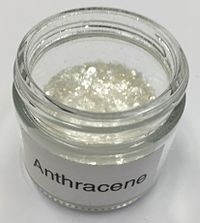Anthracene
 |
|
 |
|
 |
|
| Names | |
|---|---|
|
Preferred IUPAC name
Anthracene
|
|
|
Systematic IUPAC name
Tricyclo[8.4.0.03,8]tetradeca-1,3,5,7,9,11,13-heptaene
|
|
| Identifiers | |
|
120-12-7 |
|
| 3D model (Jmol) |
Interactive image Interactive image |
| 1905429 | |
| ChEBI |
CHEBI:35298 |
| ChEMBL |
ChEMBL333179 |
| ChemSpider |
8111 |
| DrugBank |
DB07372 |
| ECHA InfoCard | 100.003.974 |
| EC Number | 217-004-5 |
| 67837 | |
| KEGG |
C14315 |
| PubChem | 8418 |
| RTECS number | CA9350000 |
| UNII |
EH46A1TLD7 |
|
|
|
|
| Properties | |
| C14H10 | |
| Molar mass | 178.23 g·mol−1 |
| Appearance | Colorless |
| Odor | Weak aromatic |
| Density | 1.28 g/cm3 (25 °C) 0.969 g/cm3 (220 °C) |
| Melting point | 215.76 °C (420.37 °F; 488.91 K) at 760 mmHg |
| Boiling point | 339.9 °C (643.8 °F; 613.0 K) at 760 mmHg |
| 0.022 mg/L (0 °C) 0.044 mg/L (25 °C) 0.287 mg/L (50 °C) 0.00045% w/w (100 °C, 3.9 MPa) |
|
| Solubility | Soluble in alcohol, (C2H5)2O, acetone, C6H6, CHCl3,CS2 |
| Solubility in ethanol | 0.076 g/100 g (16 °C) 1.9 g/100 g (19.5 °C) 0.328 g/100 g (25 °C) |
| Solubility in methanol | 1.8 g/100 g (19.5 °C) |
| Solubility in hexane | 0.37 g/100 g |
| Solubility in toluene | 0.92 g/100 g (16.5 °C) 12.94 g/100 g (100 °C) |
| Solubility in carbon tetrachloride | 0.732 g/100 g |
| log P | 4.56 |
| Vapor pressure | 0.01 kPa (125.9 °C) 0.1 kPa (151.5 °C) 13.4 kPa (250 °C) |
|
Henry's law
constant (kH) |
0.039 L·atm/mol |
| UV-vis (λmax) | 345.6 nm, 363.2 nm |
| -130·10−6 cm3/mol | |
| Thermal conductivity | 0.1416 W/m·K (240 °C) 0.1334 W/m·K (270 °C) 0.1259 W/m·K (300 °C) |
| Viscosity | 0.602 cP (240 °C) 0.498 cP (270 °C) 0.429 cP (300 °C) |
| Structure | |
| Monoclinic (290 K) | |
| P21/b | |
| C5 2h |
|
|
a = 8.562 Å, b = 6.038 Å, c = 11.184 Å
α = 90°, β = 124.7°, γ = 90°
|
|
| Thermochemistry | |
| 210.5 J/mol·K | |
|
Std molar
entropy (S |
207.5 J/mol·K |
|
Std enthalpy of
formation (ΔfH |
129.2 kJ/mol |
|
Std enthalpy of
combustion (ΔcH |
7061 kJ/mol |
| Hazards | |
| GHS pictograms |
 
|
| GHS signal word | Warning |
| H315, H319, H335, H410 | |
| P261, P273, P305+351+338, P501 | |
|
EU classification (DSD)
|
|
| R-phrases | R36/37/38, R50/53 |
| S-phrases | S26, S60, S61 |
| NFPA 704 | |
| Flash point | 121 °C (250 °F; 394 K) |
| 540 °C (1,004 °F; 813 K) | |
| Lethal dose or concentration (LD, LC): | |
|
LD50 (median dose)
|
4900 mg/kg (rats, oral) |
|
Except where otherwise noted, data are given for materials in their standard state (at 25 °C [77 °F], 100 kPa).
|
|
|
|
|
| Infobox references | |
Anthracene is a solid polycyclic aromatic hydrocarbon (PAH) of formula C14H10, consisting of three fused benzene rings. It is a component of coal tar. Anthracene is used in the production of the red dye alizarin and other dyes. Anthracene is colorless but exhibits a blue (400-500 nm peak) fluorescence under ultraviolet radiation.
Coal tar, which contains around 1.5% anthracene, remains a major source of this material. Common impurities are phenanthrene and carbazole. A classic laboratory method for the preparation of anthracene is by cyclodehydration of o-methyl- or o-methylene-substituted diarylketones in the so-called Elbs reaction.
It may also occur in the interstellar medium. More than 20% of the carbon in the universe may be associated with PAHs, including anthracene.
Anthracene by the action of UV light:
The dimer, called dianthracene (or sometimes paranthracene), is connected by a pair of new carbon-carbon bonds, the result of the [4+4] cycloaddition. It reverts to anthracene thermally or with UV irradiation below 300 nm. Substituted anthracene derivatives behave similarly. The reaction is affected by the presence of oxygen.
Reduction of anthracene with alkali metals yields the deeply colored radical anion salts M+[anthracene]− (M = Li, Na, K). Hydrogenation gives 9,10-dihydroanthracene, preserving the aromaticity of the two flanking rings.
...
Wikipedia

